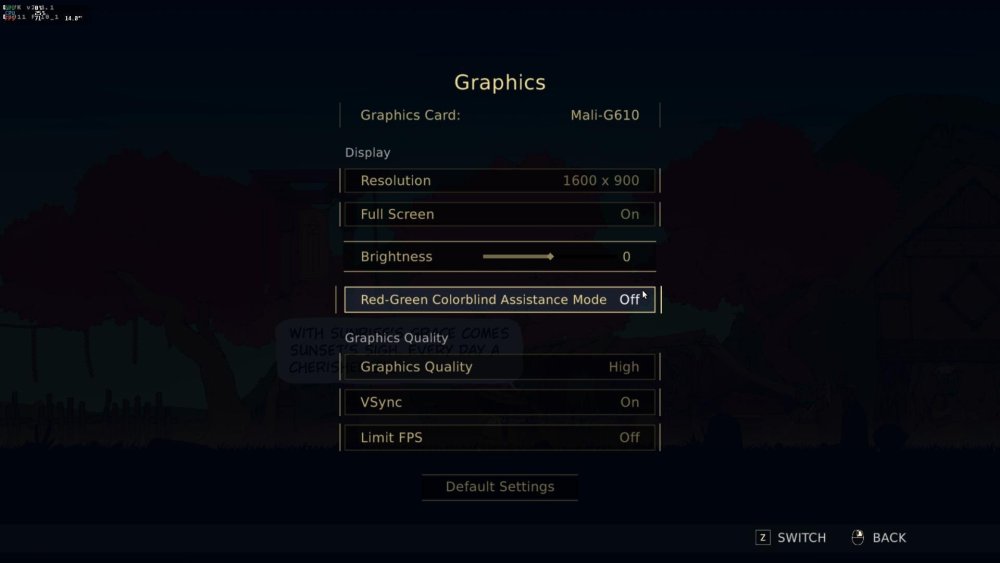Active threads
Showing topics posted in for the last 365 days.
- Past hour
-

Gaming experience with Orange Pi 5 (RK3588) on Armbian
KhanhDTP replied to KhanhDTP's topic in Orange Pi 5
Armbian 25.11.2 Noble XFCE (BSD Kernel: 6.1.115) + PanVk - mesa 26.0 (https://launchpad.net/~ernstp/+archive/ubuntu/mesaaco) + box64 3.9 (https://ryanfortner.github.io/box64-debs/) + proton-10.0-3-amd64-wow64 (https://github.com/Kron4ek/Wine-Builds/releases/download/proton-10.0-3/wine-proton-10.0-3-amd64-wow64.tar.xz) + DXVK-stripped v2.1 >=60fps@720p NineSols - Yesterday
-
I would check out the boards with Platinum Support. Go to the vendor sites to see if they include or sell a fan for their board. Look for something with a Rockchip RK3576, plenty of RAM, and EMMC or UFS. RK3588 usually needs a fan.
-
I built the latest Nobel build and ended up with Armbian-unofficial_26.02.0-trunk_Nanopiduo_noble_current_6.12.63.img. Even at idle it runs 70C. If you try to do upgrades it will do thermal shutdown. The temp reporting is real because it's hot enough to burn your finger if you hold the heat sink long enough. I used a PS2 usb fan (I call it the ghetto cooler 5000) long enough to downgrade kernel to 6.1.x. Now it idles around 50C. I know there's been heating issues with H3 (Duo uses H2+). I compared DTBs, voltages and cannot find the smoking gun. I played around controlling the voltages, etc. Anyways, I'm OK with 6.1.x kernel since this board was out in 2017. I still have a few I want to use for projects. I guess as long as I can use a current Ubuntu distro I'm OK. OK, unpacked one of my old breadboard projects on focal Linux nanopiduo 5.10.60-sunxi #21.08.2 SMP Tue Sep 14 16:28:44 UTC 2021 armv7l armv7l armv7l GNU/Linux. CPU idles cool, so I do a: sudo cat /sys/class/regulator/regulator.5/microvolts 1100000 It looks like 6.x kernel/nobel is using 1.3v. There it is. 1.1V. That confirms the mismatch perfectly. Your old Focal breadboard is running at 1.1V, while the modern Noble board is forcing 1.3V. On these chips, that 0.2V difference is massive because power (and heat) scales with the square of the voltage. Moving from 1.1V to 1.3V increases heat output by about 40%, which is why one board is a stable 50°C and the other is a 96°C furnace. So more hacking to do. I'll see if I can do a build hack.
-
Hello everybody, My Box is a oxtagon shaped t95z plus 2 mb 16 mb chipset: processor arm cortex -a53 mali T820 GPU AP6255 wifi ac + bluetooth 4.2 sandisk SDINAD1F4-16G 16G emmc 16G rom lanson L5TC4G63CFR x2 dram 2GB I try to install armbian_community_26_2 _0-trunk.100 aml-s9xx-box_noble_current_6.12.63_cinnamon_dektop.img.xz I use meson-gxm-vega-s96.dtb And u-boot-s905x-s912.dtb copy and rename as u-boot.ext It boots to ash then it stops No asking for password and user I have no clue what to do next I have entered armbian-config but this returns a error Any tips?
-
I reread it, but the information is not publicly available. Contact them directly? I haven't tried. Maybe they can help. Thanks for your time. I'll write back later; maybe someone will be interested.
-
That would be a good start indeed.
-
Yes, I am aware of this limitation.
-

mxq pro 4k 5g allwinner h313 can't sd card boot
Ducdanh Nguyen replied to Ducdanh Nguyen's topic in Allwinner CPU Boxes
Hey @Sergey Lepeshkin, i got the cable after 1-2 months now, i tried adb and all of them didn't regonize, only the middle port of the side, but i can't connect to it, it also beeps like theres a connection conflict, any solution? (There is no root on the board i tried using root detector and magisk), any help appreciated -

Need help with video decode acceleration on NanoPi R6S
Blind55 replied to Blind55's topic in NanoPi R6S/R6C
@eselarm Thank you very much for the details. I am currently working with the NanoPi R6S minimal image, with kernel 6.1 based on your feedback. I started out with the rolling release version, but that cannot run Jellyfin (because it is Forky). So I going back to the Trixie version and test this now. I will report back here whether the Jellyfin server works well with the transcoding of 4K movies (like the vendor FriendlyElec distribution does) and whether 4K movie playing can be smooth on it. - Last week
-
Board that would fit though, the H4 PLUS from hardkernel, limited to 4 sata instead of 5. 120x120, but only 2 screws would fit I believe...
-
Update, this is also working .... extraargs=reboot=watchdog UPDATE: It stopped working after 3 successful reboots...
-
Ok update.. I used a USB Ethernet to update and now the local phy is showing as end0 and it works. I'm kind of doubting my story now. I know the initial login could not connect to the Ethernet. After I installed on the local emmc and upgraded via apt upgrade things work now. I think this is a non-issue.
-

Dec 25th image for Cubie a5e is not a bootable image
eselarm replied to Meestor_X's topic in Allwinner sunxi
There is at least no primary GPT, all zeros from 0x200-0x20000 Fixed with: # gdisk Armbian_community_26.2.0-trunk.130_Radxa-cubie-a5e_trixie_edge_6.18.2_minimal.img GPT fdisk (gdisk) version 1.0.10 Caution: invalid main GPT header, but valid backup; regenerating main header from backup! Warning: Invalid CRC on main header data; loaded backup partition table. Warning! Main and backup partition tables differ! Use the 'c' and 'e' options on the recovery & transformation menu to examine the two tables. Warning! Main partition table CRC mismatch! Loaded backup partition table instead of main partition table! Warning! One or more CRCs don't match. You should repair the disk! Main header: ERROR Backup header: OK Main partition table: ERROR Backup partition table: OK Partition table scan: MBR: protective BSD: not present APM: not present GPT: damaged **************************************************************************** Caution: Found protective or hybrid MBR and corrupt GPT. Using GPT, but disk verification and recovery are STRONGLY recommended. **************************************************************************** Command (? for help): w Final checks complete. About to write GPT data. THIS WILL OVERWRITE EXISTING PARTITIONS!! Do you want to proceed? (Y/N): y OK; writing new GUID partition table (GPT) to Armbian_community_26.2.0-trunk.130_Radxa-cubie-a5e_trixie_edge_6.18.2_minimal.img. Warning: The kernel is still using the old partition table. The new table will be used at the next reboot or after you run partprobe(8) or kpartx(8) The operation has completed successfully. -
Interesting question. The dxf says the part in question is labeled ED1 besides CP18 and CP14. I found both CP18 and 14 in the schematics but ED1 not. Either mislabeled or I didn't catch it. https://x.na4.eu/KOTu3/quzevoji80.jpg OrangePi-Schematic of ZERO3.pdf
-

install bookworm 6.6.63 on x96q pro+ h728
San Dich Huu replied to hamidreza h's topic in Allwinner CPU Boxes
@Nick A, @MeJune Luckly. On this thread: https://forum.manjaro.org/t/allwinner-h728-a523-a527-t527-initial-support-thread/173654/2 He working for a year to make the linux working stable on this box. This mean kernel, dtb, ... can be replace on armbian build. I super need new image for web-service hosting purpose. Hope all function working. -

How to add private package to image?
Werner replied to Tim Zhang's topic in Advanced users - Development
Easiest approach is the customize-image.sh script in userpatches/. https://docs.armbian.com/Developer-Guide_User-Configurations/#user-provided-image-customization-script -

BPI M4 Zero 2G EMMC 8G H618 MCP2515
Netcrusher replied to Александр Архангельский's topic in Banana Pi M4 Zero
This spi-mcp251x.dts made me use can0 with SEENGREAT Dual-CH Can Hat on latest Armbian v25.11.2 for BananaPi BPI-M4-Zero running Armbian Linux 6.12.58-current-sunxi64: /* * Device tree overlay for mcp2517/18 @ can0 on SPI1.0 (BananaPi Zero M4) / Works with SEENGREAT Dual-CH Can Hat (can0 only) */ /dts-v1/; /plugin/; / { compatible = "allwinner,sun50i-h616"; fragment@0 { target-path = "/"; __overlay__ { can0_osc_fixed: can0_osc_fixed { compatible = "fixed-clock"; #clock-cells = <0>; clock-frequency = <16000000>; }; }; }; fragment@1 { target = <&pio>; __overlay__ { can0_pin_irq: can0_pin_irq { pins = "PC2"; /* Pin 22 on BananaPi BPI-M4-Zero */ function = "irq"; bias-pull-up; }; }; }; fragment@2 { target = <&spi1>; /* Use SPI1 */ __overlay__ { #address-cells = <1>; #size-cells = <0>; mcp2518fd@1 { compatible = "microchip,mcp2515"; reg = <0>; /* Use SPIx.0 */ pinctrl-names = "default"; pinctrl-0 = <&can0_pin_irq>; spi-max-frequency = <10000000>; interrupt-parent = <&pio>; interrupts = <2 2 0x08>; /* PC2 IRQ_TYPE_LEVEL_LOW */ clocks = <&can0_osc_fixed>; status = "okay"; }; }; }; }; Create file: sudo nano /boot/dtb/spi-mcp251x.dts Add overlay: sudo armbian-add-overlay /boot/dtb/spi-mcp251x.dts Edit armbianEnv.txt: overlays=bananapi-m4-pi-5-6-i2c0 bananapi-m4-sdio-wifi-bt bananapi-m4-spi1-cs0-spidev spi-mcp251x param_spidev_spi_bus=1 dtparam=spi=on param_i2c_arm_baudrate=10000 I did not try to get can1 to work since I don't need it at the moment. I hope it helps. Have fun! -
I’ve been testing Armbian on an Amlogic-based TV box, and wanted to share a short user experience. The device originally runs Android, but thanks to the Amlogic S9xx platform, it can boot Armbian from an SD card without touching the internal firmware. In my case, the system booted reliably and was usable for basic tasks like SSH access, light services, and general Linux testing. Ethernet and USB worked out of the box, while Wi-Fi and power management still required some manual tweaks, which seems common for community-supported TV boxes. For reference, the hardware I used belongs to the category of Amlogic TV boxes that are widely available on the market. These devices are not officially supported by Armbian, but they can still be interesting low-cost platforms for learning, testing, or small home projects. I’m curious if others here have experience with Armbian on similar Amlogic TV boxes, and which SoCs or configurations worked best for you.
-

Booting Armbian without EMMC
Kevin Putra Satrianto replied to Kevin Putra Satrianto's topic in Amlogic CPU Boxes
I see. Is this a hardware enforced security feature of sort? Because according to: https://docs.u-boot.org/en/latest/board/amlogic/boot-flow.html, the s905x2 can read the bootloader from sd card no matter the configuration. Only the order differs. I'm now trying to compile u-boot down from BL2 up to BL33 using this closest match of a board. It has a ddr4 memory while mine is ddr3l, but as shown in the doc it also includes ddr3 firmwares so I *hope* this will work. https://docs.u-boot.org/en/latest/board/amlogic/sei510.html However, if I'm talkin nonsense please let me know. This is my first dive into u-boot or bootloaders in general. -
Wow, thank you for this comprehensive answer. It will probably take me about as much time as until 6.19 is released to try and understand it 😂 Why does this say archlinux? And also, where to get these "idbloader.img" and "u-boot.itb" files from? The console is ttyS0, it works.
-

Have Armbian for Tanix TX1 QHZIW_H313_TX1_EMCP_V2.0?
Nick A replied to Lesano's topic in Allwinner CPU Boxes
@Lesano https://linux-sunxi.org/Tanix_TX1 shouldn’t be hard to make a armbian config for this board since it's mainlined. You probably want this patch to add wifi and hdmi. https://gitlab.manjaro.org/iuncuim/linux/-/blob/eccecabc2ca2d6efb463edc94aa0ef383d8ae200/0650-arm64-dts-allwinner-h313-Tanix-TX1-TVbox.patch You would need to boot over USB cable. I never booted over USB so I can't help with that. https://linux-sunxi.org/FEL/USBBoot


.thumb.jpg.348a71e1788f25cf8e9281dd27241c93.jpg)








